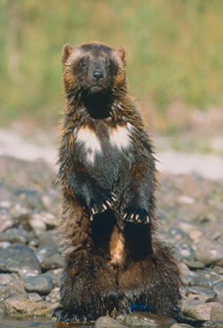 Hornocker and Hash (1981) found 70% of wolverine use in medium to scattered timber. Idaho research reported similar results, with montane coniferous forest types accounting for 70.2% of wolverine use (Copeland 1996). Southcentral Alaska wolverines preferred spruce (Piceasp.) during winter and rocky areas during summer (Gardner 1985). Male wolverines in Yukon preferred coniferous habitats in winter and avoided alpine talus in summer (Banci 1987). Whitman et al. (1986) found forest types were avoided by wolverines during summer in south-central Alaska.
Hornocker and Hash (1981) found 70% of wolverine use in medium to scattered timber. Idaho research reported similar results, with montane coniferous forest types accounting for 70.2% of wolverine use (Copeland 1996). Southcentral Alaska wolverines preferred spruce (Piceasp.) during winter and rocky areas during summer (Gardner 1985). Male wolverines in Yukon preferred coniferous habitats in winter and avoided alpine talus in summer (Banci 1987). Whitman et al. (1986) found forest types were avoided by wolverines during summer in south-central Alaska.
Preference for higher elevation habitats during summer may be related to the availability of prey (Gardner 1985, Whitman et al. 1986) or human avoidance (Hornocker and Hash 1981) while lower elevational forest types commonly associated with wild ungulates likely provide the highest carrion availability (Copeland 1996). Banci (1985) felt that low rodent availability in subalpine habitats in Yukon may have accounted for avoidance of these areas by male wolverines.
Montana wolverines were reluctant to cross openings such as clearcuts or burned areas (Hornocker and Hash 1981). Idaho wolverines commonly crossed natural openings and areas with sparse overstory such as burned areas, meadows, or open mountain-tops (Copeland 1996). Eight Idaho wolverines were relocated in burned areas at least once.
Extirpation of the wolverine through the eastern provinces of Canada and the midwestern U.S. most likely coincided with the westward advancement of civilization (Banci 1994). Throughout its North American range, the wolverine occupies a wide variety of habitats, although the character of wolverine habitat most readily apparent is its isolation from the presence and influence of humans. Habitat used by the wolverine, such as vegetative communities that support a prey base and landscape features suitable for denning habitat, may be as useful for their isolation as for their other attributes.
Hatler (1989) commented that no particular habitat components can presently be singled out specifically for wolverine and added that reduction of wilderness “refugia”, through access and alienation for timber and mineral extraction, may be the greatest threat to local population viability. The wolverine has persisted in southwestern Alberta, despite extirpation elsewhere in the province largely because of the presence of large refugia in the form of National Parks (Banci 1994).
The discovery of fossil wolverine remains in cold desert environments of southern Idaho (White et al. 1984) may characterize the species’ adaptability. Over harvest and displacement by humans may have forced the wolverine out of lowland habitats now altered by agriculture and urban development, and into the more isolated tracts of its present day distribution. The absence of wolverine from historical ranges may be related to human activity as much as from reductions in habitat. As transient wolverine (usually young dispersing individuals) attempt to colonize or travel through areas of human habitation, their probability of survival may be low.
<< Back to Species Account Overview
Literature Cited:
Complete citations for referenced literature may be viewed on the Bibliography Page.
 Follow
Follow